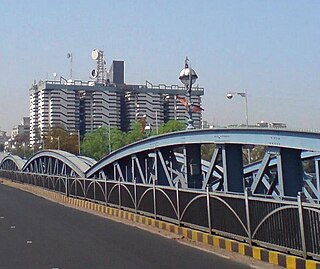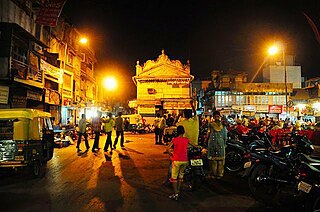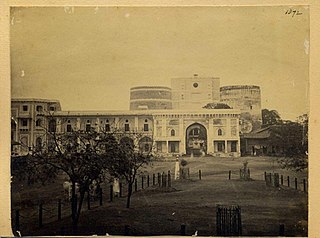
Baba Maneknath was 15th century legendary Hindu saint who lived on the banks of Sabarmati river near present city of Ahmedabad, Gujarat, India.

Baba Maneknath was 15th century legendary Hindu saint who lived on the banks of Sabarmati river near present city of Ahmedabad, Gujarat, India.
Saint Maneknath interrupted and helped Ahmad Shah I built Bhadra Fort in 1411. He wove a mat during day while the fort walls were constructed, he then unweaved the mat at night, magically crumbling down the walls. When this was discovered, he was invited to prove his powers to Ahmed Shah, by putting himself into a kettle. When he did, Ahmed Shah sealed the openings of the kettle. On the other account he helped the king to locate the site from where the construction of fort started. Under his advice the architect of city walls, Ahmad Khattu changed the layout of city. He was buried alive or took samadhi on the river island when Sabarmati river was passing through the city under Fernandez Bridge. The first quarter of the city, Manek Chowk, named after him and the memorial temple is situated there. The first bastion of the fort named after him, called Manek Burj, situated at the east end of Ellis Bridge. [1] [2] [3] [4] [5] [6]
The saint is revered in north and central Gujarat. Bharathari near Thasra in Kheda district also has his memorial where he is shown seated on his horse and is considered the patron saint of the village. There is a temple at Latol near Danta in Banaskantha district is located near the cave in the foothill where the saint is believed to have meditated. [7]
Mahant Ghanshyamnath, the 12th generation descendant of the saint, performs puja and hoists the flag on Manek Burj on the foundation day of the city and Vijayadashami every year. [3] [4] [6]

Ahmedabad is the most populous city in the Indian state of Gujarat. It is the administrative headquarters of the Ahmedabad district and the seat of the Gujarat High Court. Ahmedabad's population of 5,570,585 makes it the fifth-most populous city in India, and the encompassing urban agglomeration population estimated at 6,357,693 is the seventh-most populous in India. Ahmedabad's 2024 population is now estimated at 8,854,444. Ahmedabad is located near the banks of the Sabarmati River, 25 km (16 mi) from the capital of Gujarat, Gandhinagar, also known as its twin city.
This page provides a historical timeline of Ahmedabad, the sixth largest city in India.

The Historic City of Ahmadabad or Old Ahmedabad, the walled city of Ahmedabad in India, was founded by Ahmad Shah I of the Gujarat Sultanate in 1411. It remained the capital of the state of Gujarat for six centuries and later became the important political and commercial centre of Gujarat. Today, despite having become crowded and dilapidated, it still serves as the symbolic heart of metropolitan Ahmedabad. It was inscribed as the World Heritage City by UNESCO in July 2017.

Amdavad district is a district comprises the city of Amdavad, in the central part of the state of Gujarat in western India. It is the seventh most populous district in India.
Mahmud Begada or Mahmud Shah I was the most prominent Sultan of the Gujarat Sultanate. Raised to the throne at young age, he successfully captured Pavagadh and Junagadh forts in battles which gave him his name Begada. He established Champaner as the capital.

Himatnagar or Himmatnagar is a city and the headquarters of Sabarkantha district in the Indian state of Gujarat. The city is on the bank of the river Hathmati.

The Ellis Bridge is a century-old bridge in Ahmedabad, Gujarat. It bridges the western and eastern parts of the city across the Sabarmati river. This bowstring arch truss bridge was the first bridge in Ahmedabad, constructed in 1892. Concrete wings were added on either side in 1997 and it was renamed the Swami Vivekananda Bridge.
Ahmedabad is the largest city in the state of Gujarat. It is located in western India on the banks of the River Sabarmati. The city served as political as well as economical capital of the region since its establishment. The earliest settlement can be recorded around the 12th century under Chaulukya dynasty rule. The present city was founded on 26 February 1411 and announced as the capital on 4 March 1411 by Ahmed Shah I of Gujarat Sultanate as a new capital. Under the rule of sultanate (1411–1511) the city prospered followed by decline (1511–1572) when the capital was transferred to Champaner. For next 135 years (1572–1707), the city renewed greatness under the early rulers of Mughal Empire. The city suffered due to political instability (1707–1817) under late Mughal rulers followed by joint rule between Maratha and Mughal. The city further suffered following joint Maratha rule. The city again progressed when politically stabilized when British East India Company established the rule in the city (1818–1857). The city further renewed growth when it gain political freedom by establishment of municipality and opening of railway under British crown rule (1857–1947). Following arrival of Mahatma Gandhi in 1915, the city became centre stage of Indian independence movement. Many activists like Sardar Patel served the municipality of the city before taking part in the movement. After independence, the city was a part of Bombay state. When Gujarat was carved out in 1960, it again became the capital of the state until establishment of Gandhinagar in 1965. Ahmedabad is also the cultural and economical centre of Gujarat and the seventh largest city of India.
Ashaval or Ashapalli or Yashoval is the original name of Ahmedabad or Amdavad. Archaeological evidence suggests that the area around Ahmedabad in the state of Gujarat, India has been inhabited since the 11th century, when it was known as Yashoval or Ashapalli or Ashaval. The city of Ashaval was located on the east of River Sabarmati. Existence of Ashawal is traced way back in 9th - 10th century up till 13th century. The settlement near the bank of Sabarmati river, which is today the city of Ahmedabad, was earlier known as Ashaval or Ashapalli. In the tenth century Ashaval was one of the chief places in Gujarat as described by Al-Biruni.

Ahmad Shah I, born Ahmad Khan, was a ruler of the Muzaffarid dynasty, who reigned over the Gujarat Sultanate from 1411 until his death in 1442. He was the grandson of Sultan Muzaffar Shah, founder of the dynasty.

Sarkhej Roza is a mosque and tomb complex located in the village of Makarba, 7 km south-west of Ahmedabad in Gujarat state, India.

Jama Masjid, also known as Jumah Mosque or Jami' Masjid, is a mosque in Ahmedabad, Gujarat, India. It was built in 1424 during the reign of Ahmad Shah I. The inscription on the central mihrab commemorates the inauguration of the mosque on the 1st Safar A.H. 827 or January 4, 1424 A.D. by Sultan Ahmad Shah I. The mosque lies in the old walled city, and it is situated outside Bhadra Fort area. The old walled city is divided into separate quarters or pols, and the Jami' Masjid is found on the Gandhi Road. Along the south side of the road, the mosque is a short distance beyond the Teen Darwaza or Tripolia Gate.

Manek Chowk

Bhadra Fort is situated in the walled city area of Ahmedabad, India. It was built by Ahmad Shah I in 1411. With its well carved royal palaces, mosques, gates and open spaces, it was renovated in 2014 by the Amdavad Municipal Corporation (AMC) and the Archaeological Survey of India (ASI) as a cultural centre for the city.

Ahmad Shah's Tomb, locally known as Badshah no Hajiro or Raja no Hajiro, is a medieval mosque and the group of tombs in Ahmedabad, India. Ahmad Shah's tomb is situated close to Jama Mosque and Manek Chowk.

Rani no Hajiro, also known as Mughalai Bibi's Tomb or Tombs of Ahmed Shah's Queens, is a tomb complex near Manek Chowk, Ahmedabad, India.

Manek Burj, also spelled Manek Buraj is the foundation bastion of Bhadra Fort in the old city of Ahmedabad, Gujarat, India. The Burj is associated with legendary saint Maneknath.

The Darwaja or Gates of Ahmedabad were built during different times starting from 1411 as the entrances to the walled city of Ahmedabad, Gujarat, India.
Ghiyas-ud-Din Ahmad Shah III, born Ahmad Khan was a sultan of the Muzaffarid dynasty who nominally reigned over the Gujarat Sultanate, a late medieval kingdom in India from 1554 to 1561 though true powers were exerted by his nobles who had divided the kingdom between themselves. He was assassinated by one of his nobles.